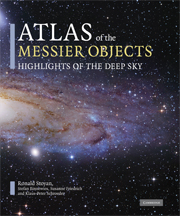Book contents
- Frontmatter
- Dedication
- Contents
- Foreword
- Preface
- User Guide
- Charles Messier
- The Observations
- The Catalog
- Statistics of the Messier objects
- Visual observation of the Messier objects
- Photography of the Messier objects
- The 110 Messier objects
- Glossary of technical terms
- Index of figures
- Index of sources
User Guide
Published online by Cambridge University Press: 05 August 2015
- Frontmatter
- Dedication
- Contents
- Foreword
- Preface
- User Guide
- Charles Messier
- The Observations
- The Catalog
- Statistics of the Messier objects
- Visual observation of the Messier objects
- Photography of the Messier objects
- The 110 Messier objects
- Glossary of technical terms
- Index of figures
- Index of sources
Summary
The data files
Degree of difficulty: rating of the observational difficulty:
1 object easily visible to the naked eye
2 object difficult to see with the naked eye
3 object easily visible in 8×30 binoculars
4 object easily visible in 10×50 binoculars
5 object difficult to see with 10×50 binoculars
For more information about visual and photographic difficulty, see page 63.
Minimum Aperture: minimum aperture required to see the object under a dark mountain sky, according to the personal experience of the first author. There are four categories:
• naked eye
• 15mm
• 30mm
• 50mm
Designation: catalog number in the NGC (New General Catalogue) or the IC (Index Catalogue).
Type: Object type. For a more detailed introduction to the different types, see page 53.
Class: Classification of the object, specific to its type:
• Galactic nebulae: distinction between emission nebula and reflection nebula, see page 53
• Open clusters: Trümpler classification, see page 55
• Globular clusters: concentration class, see page 56
• Galaxies: Hubble classification scheme, see page 61
Distance: Distance from Earth in light-years. As far as possible, uniform sources have been used, i.e.:
• galactic nebulae and open clusters: K2005 (Kharchenko, N.V., et al.: “Astrophysical parameters of galactic open clusters,” Astronomy and Astrophysics 438, 1163 (2005)
• globular clusters: R2005 (Recio-Blanco, A., et al.: “Distance of 72 galactic globular clusters,” Astronomy and Astrophysics 432, 851 (2005)
• galaxies: H2000 (multiple authors: “The Hubble Space Telescope Key Project on the Extragalactic Distance Scale,” Astrophysical Journal 529, 698, 745, 786 (2000)
• Virgo cluster galaxies: V2004 (Sanchis, T., et al.: “The origin of HI-deficiency in galaxies on the outskirts of the Virgo cluster. II. Companions and uncertainties in distances and deficiencies,” Astronomy and Astrophysics 418, 393 (2004)
• Virgo cluster galaxies: V2002 (Solanes, J.M., et al.: “The Three-dimensional Structure of the Virgo Cluster Region from Tully-Fisher and HI data,” Astronomical Journal 124, 2440 (2002)
• extragalactic HII regions: HK83 (Hodge, P.W., Kennicutt, R.C., Jr.: “An atlas of HII regions in 125 galaxies,” Astronomical Journal 88, pp.
- Type
- Chapter
- Information
- Atlas of the Messier ObjectsHighlights of the Deep Sky, pp. 10 - 14Publisher: Cambridge University PressPrint publication year: 2008
- 5
- Cited by



